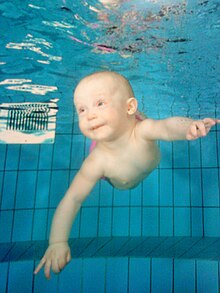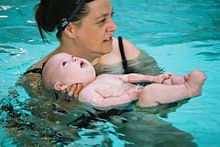At How Many Weeks Does the Baby Move Up

Babies instinctively hold their breath underwater.
Baby swimming is the phenomenon of human babies and toddlers reflexively moving themselves through water and changing their rate of respiration and centre rate in response to being submerged. The slowing of heart rate and breathing is chosen the bradycardic response.[ane] It is non truthful that babies are built-in with the ability to swim, though they have archaic reflexes that make it wait like they are. Babies are not old enough to hold their breath intentionally or potent enough to go along their head above h2o, and cannot swim unassisted.
Most infants, though not all, will reflexively hold their breath when submerged to protect their airway and are able to survive immersion in h2o for brusk periods of time.[ii] Infants can besides be taken to pond lessons. Although this may be washed to reduce their risk of drowning, the effects on drowning risk are not reliable.[3] Babies can imitate swimming motions and reflexes, just are not still physically capable of pond.
Infant swimming or diving reflex [edit]
Almost human babies demonstrate an innate swimming or diving reflex from nativity until the age of approximately six months, which are part of a wider range of archaic reflexes found in infants and babies, simply not children, adolescents and adults. Babies this young cannot actually swim, however, due to their overall lack of torso features and strength. Other mammals also demonstrate this phenomenon (see mammalian diving reflex). This reflex involves apnea (loss of drive to breathe), slowed heart charge per unit (reflex bradycardia), and reduced blood apportionment to the extremities such as fingers and toes (peripheral vasoconstriction).[1] During the diving reflex, the infant's heart rate decreases by an average of xx%.[one] The glottis is spontaneously sealed off and the h2o entering the upper respiratory tract is diverted down the esophagus into the stomach.[iv] The diving response has been shown to have an oxygen-conserving consequence, both during motility and at residue. Oxygen is saved for the heart and the brain, slowing the onset of serious hypoxic damage. The diving response tin can therefore be regarded as an important defence mechanism for the body.[5]
Drowning take chances [edit]
Drowning is a leading cause of unintentional injury and decease worldwide, and the highest rates are amongst children. Overall, drowning is the well-nigh common fatal injury among children anile 1–iv years in the USA,[six] and is the second highest cause of death altogether in that age range, after built defects.[7] [viii]
A Centers for Disease Command and Prevention study in 2012 of Us data from 2005–2009 indicated that each year an boilerplate of 513 children anile 0–four years were victims of fatal drowning and a further 3,057 of that age range were treated in U.S. hospital emergency departments for non-fatal drowning. Of all the historic period groups, children aged 0–four years had the highest death rate and also not-fatal injury charge per unit. In 2013, amid children ane to iv years old who died from an unintentional injury, almost 30% died from drowning.[6] These children well-nigh usually drowned in swimming pools, oft at their own homes.[vii] [8]
Swimming lessons for infants [edit]

Traditionally, swimming lessons started at historic period four years or subsequently, every bit children under four were not considered developmentally set up.[9] Still, pond lessons for infants take become more common. The Australian Swimming Coaches and Teachers Clan recommends that infants can start a formal plan of pond lessons at four months of age and many accredited swimming schools offer classes for very young children, specially towards the beginning of the swimming season in October.[x] In the The states, the YMCA[11] and American Ruddy Cross offering swim classes.[12] A baby has to be able to hold his or her caput upwardly (usually at 3 to iv months), to be set up for swimming lessons.[13]
Children tin exist taught, through a series of "prompts and procedures," to float on their backs to breathe, and so to flip over and swim toward a wall or other condom area. Children are substantially taught to swim, flip over and float, and so flip over and swim once again. Thus, the method is called "swim, float, swim."[fourteen] [xv]
Pros and cons of infant pond lessons [edit]
In a 2009 retrospective case-control study that involved meaning potential sources of bias, participation in formal swimming lessons was associated with an 88% reduction in the adventure of drowning in 1- to 4-yr-old children, although the authors of the study found the conclusion imprecise.[16] [17] Another study showed that infant swimming lessons may amend motor skills, just the number of study subjects was too low to exist conclusive.[18]
There may exist a link between baby pond and rhinovirus-induced wheezing illnesses.[19]
Others accept indicated concerns that the lessons might be traumatic, that the parents volition have a imitation sense of security and non supervise young children adequately around pools, or that the babe could experience hypothermia, suffer from h2o intoxication later on swallowing h2o, or develop gastrointestinal or skin infections.[twenty] [21]
Professional positions [edit]
In 2010, the American Academy of Pediatrics reversed its previous position in which it had disapproved of lessons before historic period 4,[9] indicating that the prove no longer supported an advisory against early on pond lessons. However, the AAP stated that information technology found the evidence at that time insufficient to support a recommendation that all ane- to iv-year-one-time children receive pond lessons. The AAP further stated that in spite of the popularity of swimming lessons for infants under 12 months of historic period and anecdotal evidence of infants having saved themselves, no scientific report had conspicuously demonstrated the safety and efficacy of training programs for infants that immature. The AAP indicated its position that the possible benefit of early on pond instruction must exist weighed against the potential risks (e.g., hypothermia, hyponatremia, infectious illness, and lung damage from pool chemicals).[22]
The American Centers for Disease Control and Prevention recommends swimming lessons for children from 1–four, along with other precautionary measures to preclude drowning.[7] [8] [23]
The Canadian Pediatric Society takes a eye-of-the-route approach. While it does non propose against pond lessons for infants and toddlers, it advises that they can not be considered a reliable prevention for drowning, and that lessons for children less than 4 years should focus on building confidence in the water and pedagogy parents and children h2o rubber skills. They also recommend, for all children less than four years, constant arms-length supervision for toddlers near any body of h2o (including bathtubs) and that infants be held at all times.[24]
References [edit]
- ^ a b c Goksor, E.; Rosengren, L.; Wennergren, Yard. (2002). "Bradycardic response during submersion in infant pond". Acta Paediatr. 91 (3): 307–312. doi:10.1111/j.1651-2227.2002.tb01720.x. PMID 12022304. S2CID 22213714.
- ^ Pedroso, FS (February 2012). "The diving reflex in healthy infants in the first year of life". Journal of Child Neurology. 27 (ii): 168–71. doi:10.1177/0883073811415269. PMID 21881008. S2CID 29653062.
- ^ Hassal, IB (1989). "Thirty-six consecutive nether v year erstwhile domestic swimming puddle drownings". Australian Paediatric Journal. 25 (3): 143–6. doi:ten.1111/j.1440-1754.1989.tb01438.x. PMID 2764836. S2CID 31472695.
- ^ Winston, Robert (1998). "The Human Torso". BBC. Retrieved eighteen Baronial 2014.
- ^ Alboni, Paolo; Alboni, Marco; Gianfranchi, Lorella (Feb 2011). "Diving bradycardia: a mechanism of defense against hypoxic impairment". Journal of Cardiovascular Medicine. 12 (6): 422–427. doi:10.2459/jcm.0b013e328344bcdc. PMID 21330930. S2CID 21948366. Retrieved 17 Baronial 2014.
- ^ a b Percentage chart of the causes of expiry by unintentional injury, ages 1–4 (all races, both sexes), in 2013. Sample size: 1,316. Drowning: 29.9%, motor vehicle traffic accidents: 24.8%, suffocation: 12.2%, fire/burns: 9.eight%, etc. National Center for Health Statistics (NCHS), National Vital Statistics System.
- ^ a b c Laosee, Orapin C.; Gilchrist, Julie; Rudd, Rose (May 18, 2012). "Drowning - The states, 2005-2009". Centre for Affliction Control: Morbidity and Mortality Weekly Written report. 61 (19): 344–347. Retrieved eighteen August 2014.
- ^ a b c "Unintentional Drowning: Get the Facts". Centers for Illness Control and Prevention, National Center for Injury Prevention and Control, Division of Unintentional Injury Prevention . Retrieved 18 August 2014.
- ^ a b American Academy of Pediatrics, Committee on Sports Medicine and Fitness and Committee on Injury, Violence, and Toxicant Prevention. (2000). "Swimming Programs for Infants and Toddlers". Pediatrics. 105 (4 pt one): 868–870. doi:10.1542/peds.105.4.868 . Retrieved 18 Baronial 2014.
{{cite journal}}: CS1 maint: multiple names: authors listing (link) - ^ "Swim Australia FAQs". Archived from the original on 16 October 2014. Retrieved 21 September 2014.
- ^ "Parent/Child Swim Lessons (Ages vi-36 months)". New York's YMCA . Retrieved 18 Baronial 2014.
- ^ "Swimming Classes and Water Safety". American Red Cantankerous . Retrieved eighteen August 2014.
- ^ Pratt, Sarah. "Infant Swimming Classes". Parenting . Retrieved 18 August 2014.
- ^ Main Judge Babcock (April 16, 2001). "Findings of Fact: Harvey Barnett, Inc. v. Shidler". Courtroom Listener. 143 F. Supp. 2d: 1247. Archived from the original on xviii August 2014. Retrieved 18 August 2014.
- ^ Courtroom of Appeals for the Tenth Circuit (Aug xv, 2006). "Harvey Barnett, Inc. v. Shidler". Court Listener. Archived from the original on xviii August 2014. Retrieved 18 August 2014.
- ^ Brenner, RA; Taneja, GS; Haynie, DL; Trumble, Air-conditioning; Qian, C; Klinger, RM; Klebanoff, MA (Mar 2009). "Clan betwixt swimming lessons and drowning in childhood: a case-control study". Archives of Pediatrics & Adolescent Medicine. 163 (three): 203–10. doi:10.1001/archpediatrics.2008.563. PMC4151293. PMID 19255386.
- ^ Moreno, MA; Furtner, F; Rivara, FP (Mar 2009). "H2o safety and pond lessons for children". Athenaeum of Pediatrics & Boyish Medicine. 163 (3): 288. doi:x.1001/archpediatrics.2008.572. PMID 19255402.
- ^ Dias, JA; Manoel Ede, J; Dias, RB; Okazaki, VH (Dec 2013). "Pilot report on baby swimming classes and early motor development". Perceptual and Motor Skills. 117 (three): 950–v. doi:ten.2466/10.25.PMS.117x30z2. PMID 24665810. S2CID 28391494.
- ^ Schuez-Havupalo, L; Karppinen, S; Toivonen, 50; Kaljonen, A; Jartti, T; Waris, M; Peltola, V (Jul seven, 2014). "Clan betwixt infant swimming and rhinovirus-induced wheezing". Acta Paediatrica. 103 (xi): 1153–1158. doi:ten.1111/apa.12736. PMID 25041066. S2CID 20295117.
- ^ Weeks, Carly (July xiii, 2009). "Water Safety: Can a six-month-old relieve himself from drowning?". The Globe and Mail . Retrieved 18 Baronial 2014.
- ^ "US babies learn 'cocky-rescue' from drowning". France-Presse. July 23, 2011. Retrieved 18 August 2014.
- ^ American Academy of Pediatrics Committee on Injury, Violence, and Toxicant, Prevention (Jul 2010). "Prevention of drowning". Pediatrics. 126 (i): 178–85. doi:10.1542/peds.2010-1264. PMID 20498166. Retrieved 18 August 2014.
{{cite periodical}}: CS1 maint: multiple names: authors list (link) - ^ "Drowning Happens Quickly– Learn How to Reduce Your Take chances". Centers for Disease Control and Prevention . Retrieved eighteen August 2014.
- ^ Hong Nguyen, B (2003). "Swimming lessons for infants and toddlers". Paediatrics and Child Health. 8 (2): 113–4. doi:10.1093/pch/viii.2.113. PMC2791436. PMID 20019931.
External links [edit]
- The Diving Reflex - Baby Babies Pond Underwater on YouTube
- Infant Swimming Resource: Teaching Progression on YouTube
- Babe Swim Cocky-Rescue on YouTube
Source: https://en.wikipedia.org/wiki/Infant_swimming
0 Response to "At How Many Weeks Does the Baby Move Up"
Post a Comment